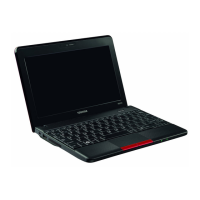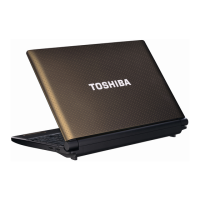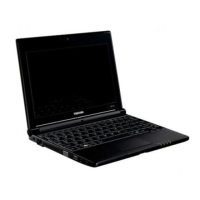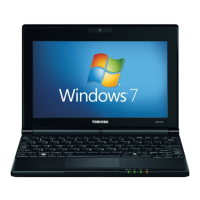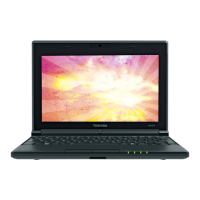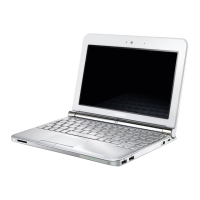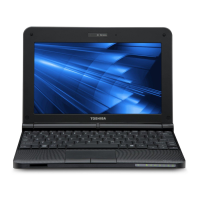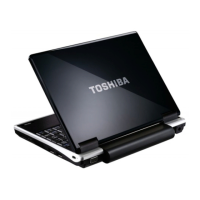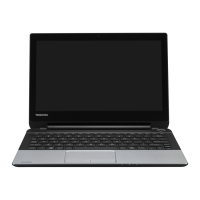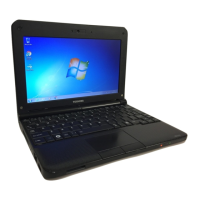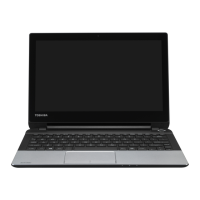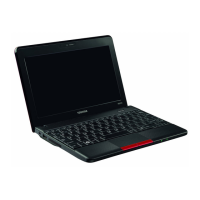
Do you have a question about the Toshiba NB510 and is the answer not in the manual?
| Bus type | DMI |
|---|---|
| Stepping | B3 |
| Processor cache | 1 MB |
| Processor cores | 2 |
| Processor model | N2600 |
| System bus rate | 2.5 GT/s |
| Processor family | Intel Atom® |
| Processor series | Intel Atom N2600 Series |
| Processor socket | BGA 559 |
| Processor threads | 4 |
| Processor codename | Cedarview |
| Processor frequency | 1.6 GHz |
| Processor cache type | L2 |
| Processor lithography | 32 nm |
| Processor manufacturer | Intel |
| Processor front side bus | - MHz |
| Processor operating modes | 64-bit |
| ECC supported by processor | No |
| Thermal Design Power (TDP) | 3.5 W |
| Motherboard chipset | - |
| Internal memory | 2 GB |
| Memory clock speed | 800 MHz |
| Internal memory type | DDR3-SDRAM |
| HDD speed | 5400 RPM |
| HDD capacity | 320 GB |
| HDD interface | SATA |
| Card reader integrated | Yes |
| Compatible memory cards | MiniSD, MMC, SD, SDHC, SDXC |
| Display surface | Gloss |
| Display diagonal | 10.1 \ |
| Display resolution | 1024 x 600 pixels |
| Native aspect ratio | 5:3 |
| Video in | 0 |
| Graphics card | GMA 3650 |
| Wireless technology | IEEE 802.11b/g/n |
| Bluetooth version | 3.0+HS |
| Cabling technology | 10/100Base-T(X) |
| Networking features | Ethernet, Fast Ethernet, WLAN |
| Ethernet LAN data rates | 10, 100 Mbit/s |
| Maximum graphics card memory | 0.762 GB |
| On-board graphics card base frequency | 400 MHz |
| Audio system | HD |
| Trial software | McAfee Internet Security |
| Bundled software | Toshiba Disc Creator, Toshiba Assist, Toshiba Value Added Package, WildTangent, Toshiba Recovery Media Creator, Nero BackItUp & Burn Autobackup Essentials, Skype, Windows Live Essentials, eBay, Amazon, Microsoft Office 2010, Google Chrome & Google Search, Nero KwikMedia, Toshiba Places & Music Place, Connectivity Doctor, ConfigFree |
| Operating system installed | Windows 7 Starter |
| Operating system architecture | 32-bit |
| Cable lock slot type | Kensington |
| Password protection type | BIOS, HDD, Supervisor, User |
| Product type | Netbook |
| Product color | Red |
| Charging port type | DC-in jack |
| USB 2.0 ports quantity | 3 |
| Pointing device | Touchpad |
| Keyboard number of keys | 86 |
| Battery life (max) | 9 h |
| AC adapter input voltage | 100 - 240 V |
| AC adapter output current | 1.58 A |
| AC adapter output voltage | 19 V |
| Sustainability certificates | ENERGY STAR |
| Processor code | SR0W2 |
| Processor ARK ID | 58916 |
| Supported instruction sets | SSE2, SSE3, SSSE3 |
| Depth | 187 mm |
|---|---|
| Width | 361.6 mm |
| Height (rear) | 34.7 mm |
| Height (front) | 13.6 mm |
Lists all hardware, documentation and software included with the computer.
Provides basic information on starting and using your computer.
Shows the computer's front with the display panel in the closed position.
Shows the condition of the DC IN and battery's charge.
Indicates the computer's power status.
Identifies components on the computer's left side.
Identifies components on the computer's right side.
Shows the computer's back and battery pack.
Shows the underside of the computer and its components.
Shows the computer with the display panel open.
Describes the internal hardware components of the computer.
Explains how to use the touch pad for cursor movement and gestures.
Describes the computer's keyboard layout and functions.
Explains the function of keys F1 through F12.
Details how to use the FN key with other keys for specific functions.
Lists and explains the functions of various hot keys.
Explains how to use the TOSHIBA Disc Creator utility.
Discusses wireless communication functions and precautions.
Details Wireless LAN specifications and settings.
Explains Bluetooth wireless technology features and operation.
Covers LAN connectivity, cable types, and connection procedures.
Lists optional devices that expand computer capabilities.
Describes the memory media slot and supported media types.
Provides safety precautions for handling memory media.
Step-by-step guide for inserting memory media.
Step-by-step guide for removing memory media.
Explains how to install and remove memory modules.
Details how to connect an external analog monitor.
Explains how to connect an HDMI monitor.
Describes how to connect a security cable to the lock slot.
Lists available optional accessories for the computer.
Describes audio control functions and settings.
Explains how to configure video mode settings.
Provides instructions for computer handling and maintenance.
Explains how the computer manages heat to prevent overheating.
Details pre-installed utilities and how to start them.
Highlights unique and advanced features for convenience.
Manages user and supervisor passwords for computer security.
Explains how to use HW Setup to configure computer settings.
Describes system recovery options and media creation.
Explains how power conditions affect operating capability and battery status.
Details how to monitor power status using indicators.
Explains battery types, use, recharging, and handling.
Provides procedures and time for charging the battery.
Explains methods to monitor remaining battery power.
Lists factors affecting battery life and how to extend it.
Shows approximate battery exhaustion times in different modes.
Offers tips to maximize the life of battery packs.
Provides instructions for removing and installing the battery pack.
Describes the three different power-up modes: Shut Down, Hibernation, Sleep.
Explains how to configure Sleep and Hibernation modes via Power Options.
Lists hot keys for Sleep and Hibernation modes.
Configures power to turn off/on with display panel.
Automatically turns off system in Sleep/Hibernation if unused.
Guidelines for effectively resolving problems.
Basic checks for common issues before deeper troubleshooting.
Questions to ask to identify the cause of malfunction.
Troubleshoots problems related to software or disk media.
Troubleshoots problems related to computer hardware.
Addresses issues like frozen programs or system startup failures.
Steps to diagnose and fix startup issues.
Lists common problem areas in hardware and peripherals.
Discusses power-related issues and resources.
Troubleshoots issues with AC power connection.
Troubleshoots battery-related problems.
Addresses issues with BIOS settings and date/time loss.
Troubleshoots keyboard problems like wrong key output.
Discusses display panel issues and setup configuration.
Troubleshoots problems with the hard disk drive.
Refers to Chapter 3 for memory media card information.
Refers to USB device and mouse documentation for pointing issues.
Troubleshoots Touch Pad functionality and settings.
Troubleshoots USB mouse operation and connectivity.
Troubleshoots issues with USB devices not working.
Refers to audio device documentation for sound system issues.
Troubleshoots issues with external monitors.
Troubleshoots LAN connectivity and Wake-up on LAN.
Troubleshoots wireless LAN access issues.
Troubleshoots issues with Bluetooth device connectivity.
Information on obtaining technical assistance from TOSHIBA.
Summarizes the computer's physical dimensions.
Lists ambient temperature and humidity requirements.
Details AC adaptor and computer power specifications.
Specifies the required wire size for AC power cords.
Specifies the required current rating for AC power cords.
Lists international certification agencies for power cords.
Explains that not all icons may apply to the selected model.
Legal footnotes regarding CPU performance.
Legal footnotes concerning main system memory usage.
Legal footnotes regarding battery life variations and replacement.
Legal footnotes about HDD capacity reporting.
Legal footnotes on LCD screen brightness deterioration.
Legal footnotes on GPU performance variations.
Legal footnotes on wireless LAN transmission speed.
Legal footnotes on media copy protection standards.
Details Wireless LAN compatibility and standards.
Details Bluetooth compatibility and standards.
Warns about potential performance issues with wireless devices.
Information on radio frequency standards and usage.
Restrictions for using 2.4GHz frequencies in Europe.
Compliance with Industry Canada regulations.
Compliance with FCC rules for digital devices.
Safety caution regarding RF radiation exposure.
Requirements for radio frequency interference.
Regulations for radio frequency devices in Taiwan.
Important notices and indications for use in Japan.
Details device authorizations for wireless modules.
Lists approved countries/regions for wireless devices.
